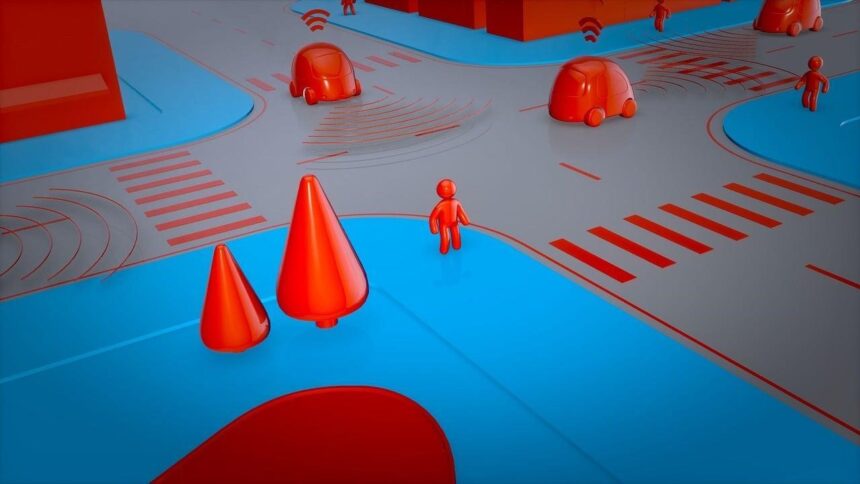AI innovations are reshaping urban mobility with technology like self-driving cars and smart signals. Self-driving tech promises fewer crashes by reducing human error, the leading cause of accidents on the roads.
Meanwhile, adaptive traffic systems ease congestion and prevent mishaps at intersections all the while relying on real-time data.
In this article, we will explore the present landscape of AI in road safety to help you understand what the future of road safety holds.
Autonomous Vehicles
Self-driving cars represent a leap in road safety, significantly minimizing accidents due to human error. This technology relies on sensors, cameras, and machine learning algorithms that consistently scan environments for potential hazards. Companies like Tesla and Waymo lead the charge with innovations in autonomous driving.
Advanced AI systems manage complex tasks like lane-keeping and collision avoidance. As cities gradually integrate self-driving cars into their networks, predictions are that there will be fewer crashes and enhanced mobility options – ushering in an era of safer commutes.
Smart Traffic Management Systems
Another crucial AI innovation is smart traffic management. These systems use real-time data from various sensors and cameras to optimize traffic flow, reduce congestion, and improve safety. They can also adjust light timings dynamically based on current conditions.
Moreover, these systems enhance emergency response times by prioritizing routes for first responders, ensuring help arrives earlier, increasing the chances of saving lives in severe accidents. Cities like Singapore have successfully implemented such systems with outstanding results.
AI-Powered Predictive Analytics
AI-powered predictive analytics is also making significant strides in enhancing road safety. These tools analyze vast amounts of data from traffic patterns, weather conditions, and historical accident reports to predict potential danger zones or high-risk times for accidents. Urban planners and city officials use these insights to design safer road layouts and implement timely preventive measures.
In cities like Los Angeles, predictive analytics help identify where additional signage or lighting could make a difference.
Additionally, this approach enables more strategic deployment of law enforcement officers during peak hours to deter risky behaviors like speeding or drunk driving.
Connected Vehicle Technology
As predictive analytics enhance urban planning, connected vehicle technology revolutionizes road communication. This innovation allows vehicles to communicate with each other and infrastructure, exchanging critical information about speed, location, and hazards.
These exchanges enable timely alerts for drivers about potential dangers, allowing them sufficient time to react. The uptick of this technology in the future will transform safety by fostering a cohesive ecosystem where cars anticipate risks faster than humans ever could.
Driver Assistance Systems
AI has also paved the way for advanced driver assistance systems (ADAS), significantly enhancing road safety. These systems include adaptive cruise control, lane departure warnings, and automatic emergency braking. Utilizing AI algorithms, ADAS continuously monitors vehicle surroundings to prevent accidents before they occur.
Currently, many new cars come equipped with basic versions of these technologies. Future projections indicate widespread adoption as these features become standard. The impact on road safety will be substantially fewer collisions, translating into lives saved and reduced traffic congestion.
Pedestrian Detection Systems
Pedestrian detection systems utilize advanced cameras and sensors to recognize pedestrians near a vehicle’s path, prompting the car to take corrective action like braking or swerving if necessary.
Adoption rates for this technology are increasing as more automakers integrate it into their safety features. This advancement promises to drastically reduce pedestrian accidents by adding an extra layer of caution where human reflexes may fall short, ultimately creating safer city environments for everyone.
The Human Factor in AI-Driven Roads
AI significantly enhances road safety but may not entirely eliminate accident risks. Being prepared for such possibilities is crucial. Engaging with a car accident attorney can provide vital assistance if you have suffered harm in an AI-related incident.
Navigating claims involving AI demands understanding technology’s role and the extent of its influence on driving decisions. While systems make driving safer, liability often remains human-driven – typically linked to actions or failures in using tech appropriately.
Experience and familiarity with autonomous systems are essential when choosing representation for such cases.
Looking Ahead
The future of AI in road safety appears promising. Innovations continue to advance, fostering safer environments for drivers and pedestrians alike. As adoption rates climb, technology’s role will expand from simple assistance to potentially eliminating many traditional road hazards.
Continued collaboration between tech companies, urban planners, and legal experts is key in navigating emerging challenges while embracing new opportunities as they come.






